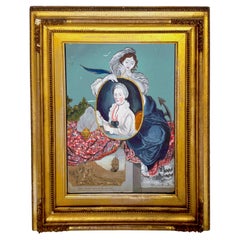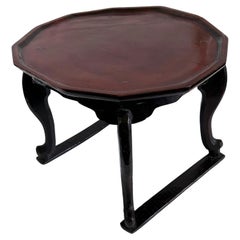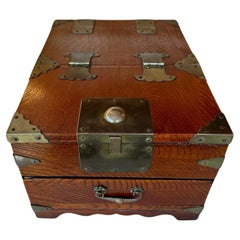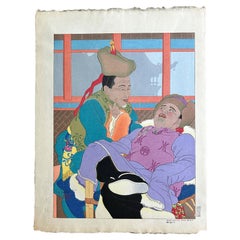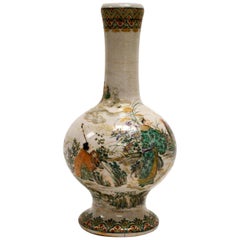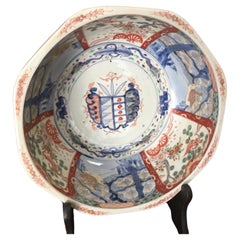Georgia - Asian Art and Furniture
Late 18th Century Chinese Chinese Export Antique Georgia - Asian Art and Furniture
Enamel
Late 19th Century Korean Other Antique Georgia - Asian Art and Furniture
Wood
20th Century Korean Other Georgia - Asian Art and Furniture
Brass
1940s Japanese Japonisme Vintage Georgia - Asian Art and Furniture
Paper
Mid-19th Century Japanese Japonisme Antique Georgia - Asian Art and Furniture
Ceramic
Mid-18th Century Japanese Edo Antique Georgia - Asian Art and Furniture
Porcelain
Late 18th Century Korean Other Antique Georgia - Asian Art and Furniture
Ceramic
Early 1900s Chinese Chinese Export Antique Georgia - Asian Art and Furniture
Glass, Wood, Paint
1910s Japanese Taisho Vintage Georgia - Asian Art and Furniture
Paper
20th Century Cambodian Georgia - Asian Art and Furniture
Bronze
Early 1900s Japanese Japonisme Antique Georgia - Asian Art and Furniture
Brocade, Silk, Paper
1950s Japanese Japonisme Vintage Georgia - Asian Art and Furniture
Paper
15th Century and Earlier Chinese Tang Antique Georgia - Asian Art and Furniture
Chrome
20th Century Chinese Chinese Export Georgia - Asian Art and Furniture
Mirror, Precious Stone, Lacquer
19th Century Chinese Antique Georgia - Asian Art and Furniture
Wood
Early 20th Century Korean Other Georgia - Asian Art and Furniture
Ceramic
1920s Japanese Japonisme Vintage Georgia - Asian Art and Furniture
Paper
19th Century Korean Other Antique Georgia - Asian Art and Furniture
Iron
Early 1900s Japanese Japonisme Antique Georgia - Asian Art and Furniture
Ceramic
15th Century and Earlier Chinese Archaistic Antique Georgia - Asian Art and Furniture
Stoneware
1950s Chinese Chinoiserie Vintage Georgia - Asian Art and Furniture
Brass
1950s Chinese Chinese Export Vintage Georgia - Asian Art and Furniture
Bronze
1820s Chinese Chinese Export Antique Georgia - Asian Art and Furniture
Ceramic
19th Century Burmese Antique Georgia - Asian Art and Furniture
Wood
19th Century Japanese Edo Antique Georgia - Asian Art and Furniture
Wood, Lacquer
20th Century Chinese Georgia - Asian Art and Furniture
Celadon
Late 18th Century Persian Islamic Antique Georgia - Asian Art and Furniture
Wood
Mid-20th Century Chinese Georgia - Asian Art and Furniture
Porcelain
20th Century Chinese Chinese Export Georgia - Asian Art and Furniture
Copper, Enamel
20th Century Chinese Chinese Export Georgia - Asian Art and Furniture
Stone
1930s Japanese Japonisme Vintage Georgia - Asian Art and Furniture
Wood, Paper
Early 1900s Japanese Meiji Antique Georgia - Asian Art and Furniture
Silk, Wood
Mid-18th Century Chinese Antique Georgia - Asian Art and Furniture
Porcelain
19th Century Korean Other Antique Georgia - Asian Art and Furniture
Wood
19th Century Japanese Japonisme Antique Georgia - Asian Art and Furniture
Ceramic
Early 20th Century Japanese Japonisme Georgia - Asian Art and Furniture
Ceramic
Mid-20th Century American Modern Georgia - Asian Art and Furniture
Ceramic
20th Century Chinese Qing Georgia - Asian Art and Furniture
Stone
Early 20th Century Korean Other Georgia - Asian Art and Furniture
Brass
Early 20th Century Japanese Japonisme Georgia - Asian Art and Furniture
Silk, Wood
1880s Japanese Japonisme Antique Georgia - Asian Art and Furniture
Ceramic
19th Century Chinese Chinese Export Antique Georgia - Asian Art and Furniture
Stone
Early 1900s Japanese Meiji Antique Georgia - Asian Art and Furniture
Silk, Wood
1930s Japanese Vintage Georgia - Asian Art and Furniture
Bronze, Enamel, Metal
1880s Chinese Meiji Antique Georgia - Asian Art and Furniture
Brass
A good quality antique porcelain vase depicting two women picking flowers under a colorful tree. Lion head handles and story marked to verso.
Ap...
20th Century Chinese Chinese Export Georgia - Asian Art and Furniture
Porcelain
Early 1900s Japanese Meiji Antique Georgia - Asian Art and Furniture
Paper
Early 2000s Japanese Modern Georgia - Asian Art and Furniture
Ceramic
19th Century Japanese Meiji Antique Georgia - Asian Art and Furniture
Ceramic
1890s Japanese Japonisme Antique Georgia - Asian Art and Furniture
Wood, Lacquer
18th Century Burmese Ming Antique Georgia - Asian Art and Furniture
Ceramic
19th Century Chinese Qing Antique Georgia - Asian Art and Furniture
Stone
Early 1900s Japanese Meiji Antique Georgia - Asian Art and Furniture
Ceramic
Early 1900s Japanese Anglo-Japanese Antique Georgia - Asian Art and Furniture
Enamel
19th Century Japanese Meiji Antique Georgia - Asian Art and Furniture
Porcelain
Early 19th Century Japanese Japonisme Antique Georgia - Asian Art and Furniture
Brocade, Paper
19th Century Chinese Chinese Export Antique Georgia - Asian Art and Furniture
Porcelain
Early 20th Century Japanese Japonisme Georgia - Asian Art and Furniture
Porcelain
Early 20th Century Chinese Chinese Export Georgia - Asian Art and Furniture
Serpentine
Late 19th Century Chinese Qing Antique Georgia - Asian Art and Furniture
Silver
Read More
Symbols of Happiness and Rebirth Adorn This Japanese Satsuma Bowl
Decorated with white cranes and the sought-after thousand-butterflies motif, the Meiji-period vessel offers both a celebration of traditional aesthetics and a clear reflection of the era’s appetite for exquisite export pieces.
Chicago’s Pagoda Red Has a Spirited Mix of Asian Antiques and Bold New Art
For 25 years, gallerist Betsy Nathan has leveraged her keen eye and key connections to bring a unique selection of rare finds to the market.
In L.A., Gallerist JF Chen Has Long Championed Eclectic Blue-Chip Design
Now working alongside his daughter Bianca, dealer Joel Chen has presented a most covetable array of antiques, art and contemporary creations for more than 40 years.
12 Calming Spaces Inspired by Japanese Design
From cherry-blossom-adorned walls paired with glamorous lighting to wood-paneled ceilings above checkerboard-patterned chairs, these 12 spaces seamlessly blend Eastern and Western aesthetics.
Rodrigo Rivero Lake’s Mexico City Showroom Is a Museum-Worthy Trove of Spanish Colonial and Asian Antiques
The dealer and curator has spent the past 50 years amassing a collection of exceptional art, furniture and architectural elements that trace the cultural influence of the Spanish empire from Europe to the Americas and beyond.
16 Refined Asian-Inspired Interiors
These spaces exemplify how Eastern elements elevate a home's decor.
